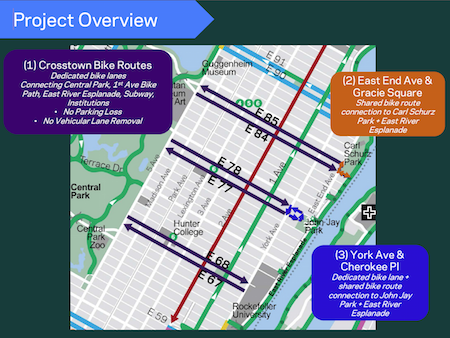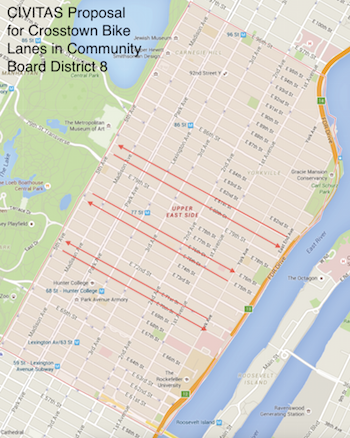
BY JACKSON CHEN | Unsatisfied with the city’s Department of Transportation route recommendations, the majority of Community Board 8 –– as well as many neighborhood residents on hand –– requested alternatives to the Upper East Side crosstown bike lanes proposal during its full board meeting on March 16.
Cyclists, pedestrians, and motorists at the meeting contributed several hours to the lengthy debate about implementing three pairs of crosstown bike lanes first laid out by the DOT on February 3.
Responding to widespread calls from the community, the agency had proposed adding six bike lanes spanning the East Side from the eastern edge of Central Park to the East River Esplanade. The proposal included three westbound routes along East 85th, East 77th, and East 67th Streets and three accompanying eastbound lanes on East 84th, East 78th, and East 68th Streets. The three pairs were chosen, according to the DOT, to link to the MTA’s Lexington Avenue Subway and cultural institutions along those routes.
Despite facing significant criticism during the proposal’s unveiling in February, DOT officials came back to CB8’s Transportation Committee meeting on March 2 with the same routes and argued they were the best options. Still unhappy, the committee considered a resolution requesting that the agency look at every crosstown block on the Upper East Side for alternatives.
The majority of the full board last week, however, decided instead to go with a more modest resolution, simply requesting that the DOT come back with three alternative pairs of crosstown bike lanes.
As CB8 waits for the agency to come back with some more choices, civic groups have already submitted their own suggestions to the DOT.
Civitas, an Upper East Side and East Harlem nonprofit, sent its recommendations in earlier this month. Its proposal includes westbound routes on East 81st, East 75th, and East 71st Streets with eastbound companion corridors on East 80th, East 76th, and East 70th Streets.
Jameson Mitchell, the organization’s executive director, said the group selected its routes after combing the neighborhood for quieter streets with modest amounts of traffic. He emphasized that the group avoided choosing blocks with crosstown bus service or an excess of institutions like schools, hospitals, or emergency services.

Civitas’ proposal incorporated several key DOT considerations –– having the pairs be approximately half a mile apart and easily accessible to Central Park’s transverse routes.
Joining Civitas in providing alternatives, the 84th Street Citizens Alliance also put in its suggestions –– a westbound East 81st Street route to be accompanied by an eastbound one on either East 80th or East 82nd Street. According to Wendy Abrams, a member of the alliance, the people involved performed a “street scan” of pedestrians, cyclists, and motorists in an effort to locate quiet, safe streets that are similar to East 90th and East 91st Streets, which already have crosstown bike lanes.
“The DOT is not going to spend as much time as the residents, the community, and the people who live here,” Abrams said of her group’s efforts. “We just feel like funneling bicycles into an already crowded, busy transverse street is an ill-conceived plan.”
Abrams said the DOT received but has not replied to her group’s proposal. The agency acknowledged receiving Civitas’ proposal, but the organization hasn’t heard anything since, Mitchell said.
The advocates for the DOT’s original proposal see all the efforts at seeking alternatives as little more than delaying tactics intended to block the implementation of bike lanes they view as beneficial.
“The DOT knows which are the best streets, they’re traffic experts,” said Steve Vaccaro, a 15-year resident and daily cyclist on the Upper East Side.
Vaccaro, who’s been following the crosstown bike issue since its inception, said he assumed there would always be opposition to DOT’s proposals, but was unhappy with what he sees as unproductive debates.
“I predict that this [proposal] is going to go around and around and around in circles,” Vaccaro said.
Still, even though he supports the DOT proposal, he also expressed concerns about putting crosstown bike lanes on streets in the East 60s that also carry city buses.
Street crowdedness was only part of the concerns and outcry that came from residents, who questioned what criteria and decision process the DOT utilized to select the three crosstown pairs.
With so much commotion coming from community members, City Councilmember Dan Garodnick sent a letter to the DOT’s Manhattan borough commissioner, Margaret Forgione, asking for a “clearer articulation of your standards, methodology, the minimum criteria for street selection, and the basis of your recommendations.”
According to a DOT spokesperson, the agency looked at all of CB8’s streets south of the existing East 90th and East 91st crosstown bike lanes. The DOT, the spokesperson said, will review the CB8 comments and determine next steps once it receives the board’s resolution.
Most residents who spoke out against the DOT’s proposal emphasized that they weren’t against installing crosstown bike lanes, but instead simply wanted a better process for choosing the optimal routes that are safest.
“[DOT has] their expertise, there’s no question about it,” the 84th Street Citizens Alliance’s Abrams said. “But there has to be something said about the people who live and work here.”


































